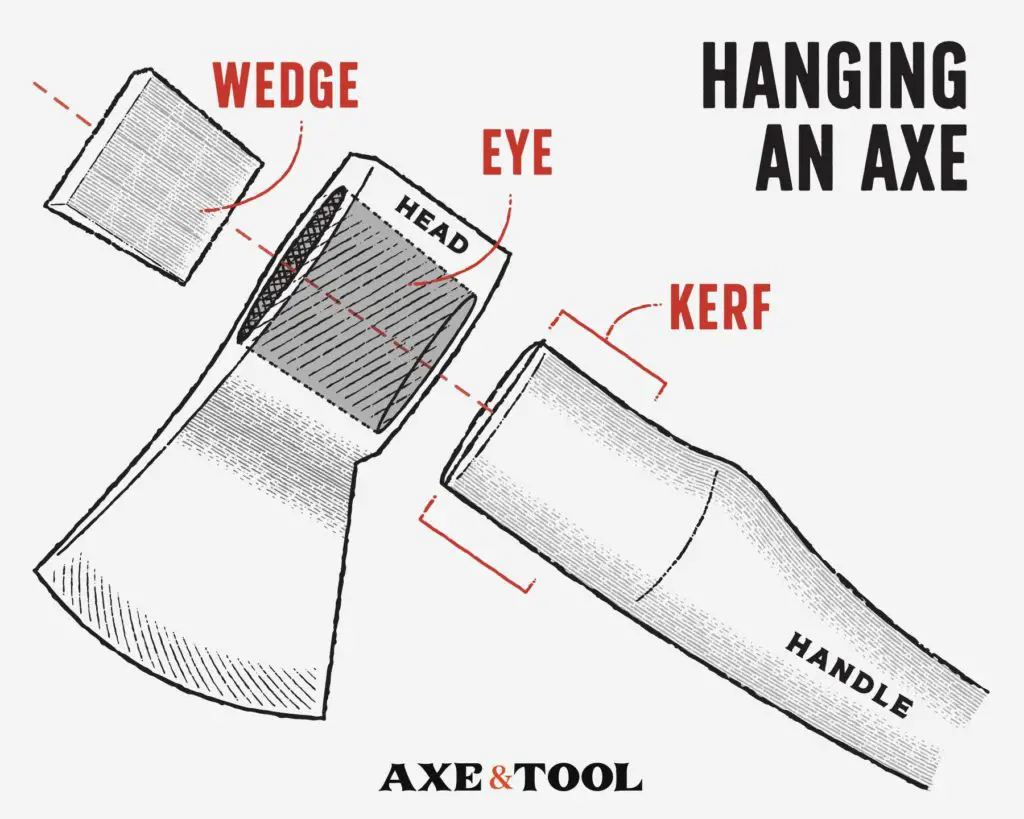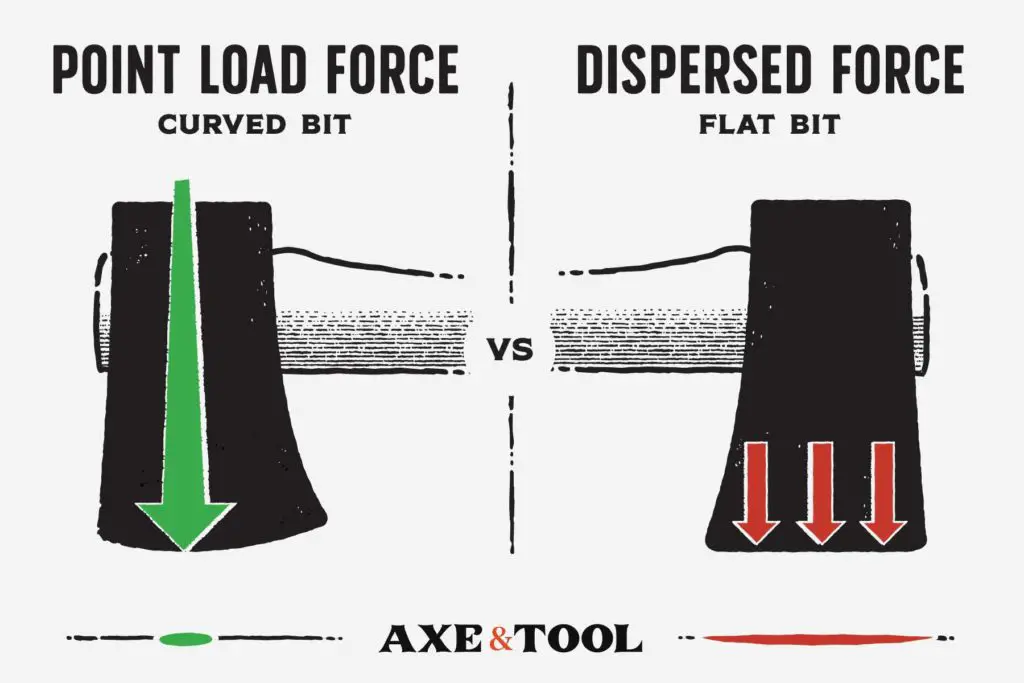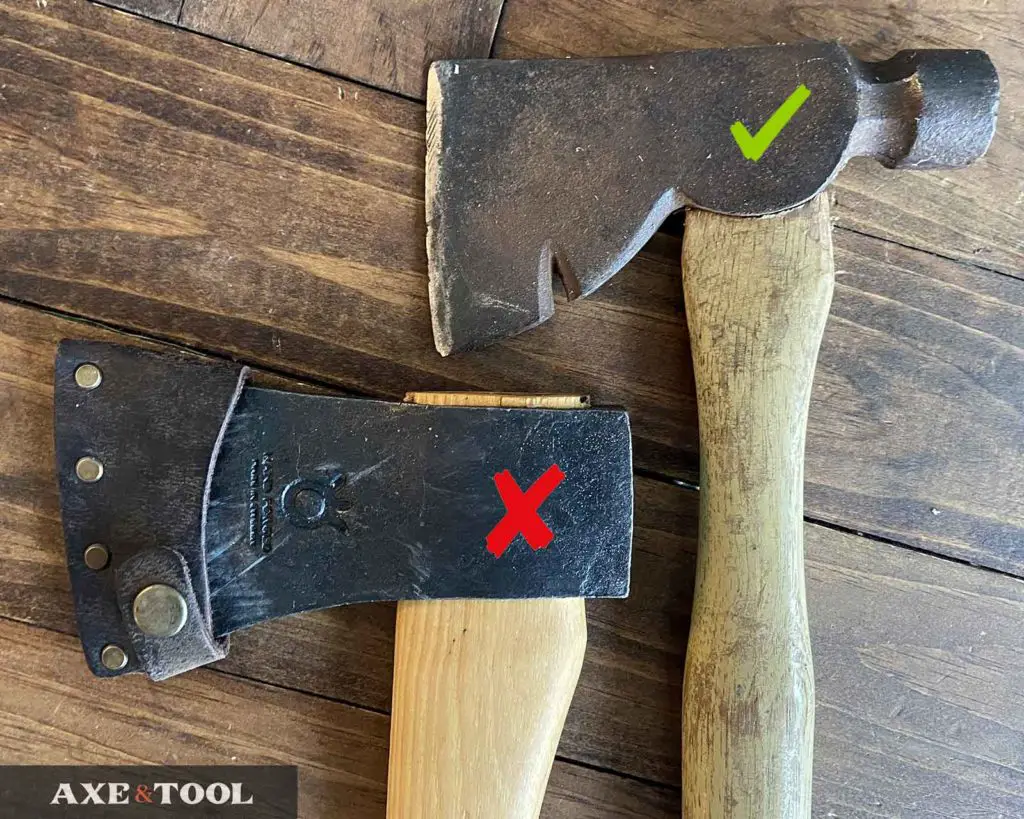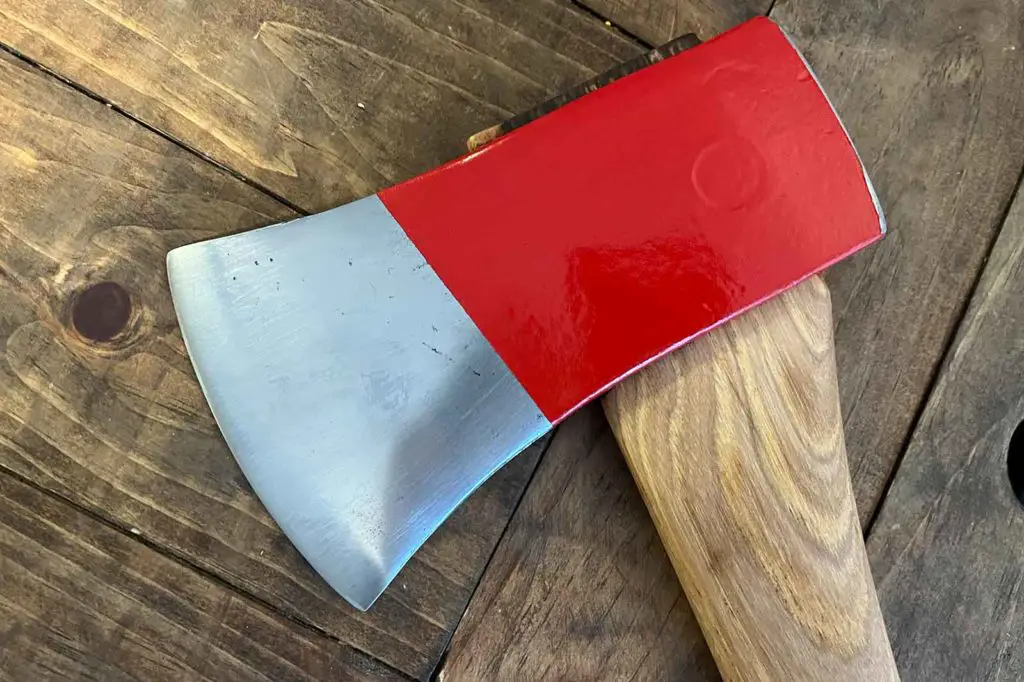17 Common Axe Questions (answered)

This is just a hobby, but if you buy through a link I may get a commission that supports the site. Thanks!
Here are a bunch of commonly asked questions that I also had when I got started with axes, so hopefully this is a useful starting point for you.
1. How do axe heads stay on?

Friction keeps axe heads in place. The handle is slotted so when it’s fitted through the bottom of the head, a wooden wedge can be hammered in from the top. This expands the handle against the inside of the head, holding it in place. A metal wedge may be added for extra pressure if needed.
Traditionally the metal wedge was only added to tighten a loose axe head but currently is almost always added from the start.
For more details and pictures, I have a full article on this here.
2. Why are some axes double-sided?
Double-bit axes were used by loggers to improve capability without needing to carry multiple axes. Each bit could be shaped for a different use, often one aggressive edge for chopping, and one strong edge for work near the ground. Or it could be used twice as much without sharpening.
It is commonly stated that the more durable side would be left dull or blunt, which is not true. Both sides would be sharp, they would just have different angles. The aggressive chopping angle might be 20° to cut deep, while the more durable cutting edge might be more like 30°, and used for roots, chopping near the ground, or tough wood.
3. Is there a weight-to-length ratio for axes?
While there isn’t a fixed ratio between the axe head weight and the handle length, there are 4 general size groups that are fairly consistent. There are exceptions and specialized axes, but this covers the most common range of axes.
Axe weight to length guide
| Size | Weight | Length |
|---|---|---|
| Hatchet | 1 – 1.5 lbs | 12” – 17” |
| Small axe | 1.5 – 2 lbs | 18” – 23” |
| Boy’s axe | 2 – 3 lbs | 24” – 29” |
| Full-size axe | 3 – 4 lbs+ | 30”-36” |
4. Why are axe blades curved?
Axe blades are curved to point load the force of the swing and cut deeper. All the force is concentrated into the small point of the curve that makes first contact with the wood. A curve also makes the cutting edge longer and allows the swing momentum to rock the blade forward, extending the cut.

There is more to it than that, see the more detailed article with ratios and pictures here.
5. Why are axe handles curved?
There are two different potential curves in an axe handle:
- The middle (belly) of the handle may curve forward so the top hand keeps the axe balanced during horizontal swings. The blade side of the head is typically heavier, so the forward curve centers the balance better.
- The handle bottom (grip) may curve back to allow for more rotation. This gives the user a wider range of cut angles and delivers slightly more rotational force.
Curves aren’t a requirement and you might even want a straight handle. Different types and patterns of axes could be better suited to handles with deep, shallow, or even no curves. You just need to know what to look for.
6. Curved vs Straight Axe handles?

Curved axe handles are more ergonomic and balanced for a wider range of cutting angles, and are best for felling and chopping.
Straight handles provide a consistent strike, are stronger, and are more common on splitting axes and reversible axes like double-bits or half-hatchets.
This is a bit of an oversimplification, and most axe users would say to use whatever is most natural to you. I have a much more detailed article here.
7. Why are axe handles made of wood?
Axe handles are made from wood because it’s flexible, strong, and can easily be cut and shaped to fit the head and user’s needs. The flexibility is important as it softens the impact of the strike and enables the user to chop longer, but the type of wood needs to be strong enough to flex without breaking.
8. Why are axe handles made of hickory?
American hickory is the most common wood used for axe handles because of its ideal balance of strength and flexibility. Ash and White oak have also been commonly used in North America, while woods like Elm were traditionally used in Europe where no stronger woods were available locally.
Now hickory is the standard on axes from all over the world since it can easily be shipped anywhere. But every country will have a local type of wood that would have been used before this.
9. What are axe handles called?
Traditional terms for an axe handle are the haft or the helve. However, handle is the most widely used name today.
10. Can I use my hatchet as a hammer?

Most axes and hatchets should not be hammered or used as a hammer. Typically only the blade is hardened, so hammering will cause damage to the softer steel. The poll (back) can mushroom, chip, or crack, and the eye can warp. However, some specialized axes have a hardened poll and can be used as a hammer.
Unless you know the poll has been hardened, assume it’s not.
It’s usually obvious when an axe has a hardened pole because it’s designed to look more like a hammer-like, or advertised visibly (it’s a great feature). But you can also look for a temper line where the hardening stops/starts.
If you want a good hatchet with a hardened poll, check out the Council Tool Flying Fox or the Husqvarna 13″ Composite hatchet.
11. Why do axes have notches?
There are 3 common reasons for a notch in an axe head: nail pulling, stress redirection, or leaving space for the user’s hand to choke up on the handle.
- Nail pullers can be found in some hatchets, and are typically on the bottom of the blade. However, they can also be found on the top of the head, actually in the bit (blade) itself, or on the back (the pole) of the head.
- An axe head might have a small notch at the bottom of the head right before the blade connects with the handle. This notch moves the stress/leverage point up into the head and away from the handle. Without it, all the force of a swing can be transferred to the front of the handle. This can loosen a head over time as it compresses the front of the handle down.
The small notch also lightens the blade side of the axe (slightly) to improve the balance of horizontal swings.
- A large notch or space under the head between the blade and the handle allows you to choke up on the axe and use the head for fine carving tasks. Ideally, the eye of the axe extends lower again over the eye to keep a stronger hold of the handle and avoid loosening.
If the large notch under the blade is shaped like an upside-down U, and the bottom of the blade is unsupported by the rest of the head then it would be a bearded axe.
For visuals check out my more detailed article about this with diagrams and pictures.
12. What is a Bearded Axe?
A bearded axe has a long cutting edge that drops down and is only connected to the handle at the top of the head. This leaves an open space behind the blade for the user’s hand, allowing it to be manipulated for finer tasks. It is commonly seen as a Viking-style axe.
13. Why are axes painted?

The Head and end of an axe handle are often painted a bright color for easy visibility. Both to avoid losing your axe and for overall safety. The head can also be painted to reduce corrosion and rusting of the head.
You generally don’t want to paint the entire handle of an axe, it will stop you from being able to oil the wood and lead to the handle drying out. Some axe users don’t like using painted handles, as the coating can be more likely to lead to blisters. But this would only be from heavy use.
If you want tips for the best paint finish, check out how to paint an axe head.
14. Why are axes painted red?
Axe heads are painted to stop corrosion, but bright colors (like red) are used for visibility in the woods, safety, and marketing. Red has been common in the US and has become the iconic color because of American media, but blue, yellow, black, and gold are all common axe colors as well.
The Kelly Woodslasher was a very common red axe in the US up until the 80s, and Council Tool has kept the tradition alive still with an iconic red axe line. They are both probably partially responsible for the prevalence of red axes in the media.
Back in the “golden years” of the axe (roughly 1890s-1940s), axe branding and marketing was a big deal, and the stamps, labels, and colors were a big part of that. Some heads were quite colorfully painted, with multi-color designs – but red always stands out, and so has been a long-time favorite.
15. Why are fire axes red?
Fire axes are painted bright red to be highly visible and ensure safety for everyone on the scene. They really could be any bright color, but there is usually a desire to match the red engine.
16. Are knots in an axe handle okay?
Knots within an axe handle can be fine but aren’t ideal and are a weak point. Axe handles rely on flexibility, and a knot interrupts the grain so the fibers may crack around it when used. The placement and depth of the knot really impacts how compromising it will be to the handle strength.
If the knot is at either end of the handle, or small and shallow on the surface it should be fine. But a big knot anywhere near the middle of the handle is more likely to be an issue. The harder knot will interfere with the flex and become a weak point that could break.
17. Why burn or char an axe handle?
Burning or charring an axe handle is a cosmetic finish for an axe. While it is sometimes called fire “hardening” it’s really only darkening the outer grain, as you don’t want a hard handle – it needs to be flexible. Fire hardening for things like wood steaks does exist but not for flexing handles
About the author:
About the author:
Jim Bell | Site Creator
I’m just a guy who likes axes. I got tired of only finding crap websites, so I set out to build a better one myself.
I’m also on Instagram: @axeandtool
Please comment below If I missed something or if you have any questions. I do my best to respond to everyone.

